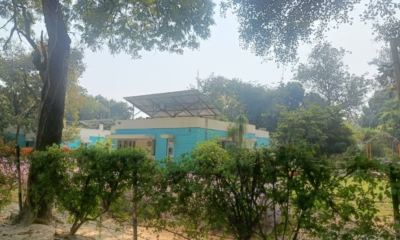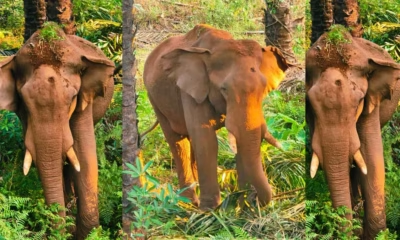Society
Death toll 280 & counting: what is the science behind Kerala’s deadly landslides?
Haunting images reveal uprooted trees, homes reduced to rubble, and bridges shattered, all swallowed by muddied waters. Each scene tells a story of loss, despair, and the enduring resilience of those affected

The landslides in Wayanad, a tourist-friendly district in the southern Indian state of Kerala, are rapidly becoming one of the most devastating natural disasters the region has ever seen. Entire areas in Chooralmala and Mundakai villages have been washed away, with local media reporting the destruction of over 250 homes. Tragically, the death toll has surpassed 280, marking a grim chapter in the region’s history.
The disaster, the worst since the devastating floods of 2018, has left a heart-breaking trail of destruction. Haunting images reveal uprooted trees, homes reduced to rubble, and bridges shattered, all swallowed by muddied waters. Each scene tells a story of loss, despair, and the enduring resilience of those affected.
Nestled in the rugged terrain of the Western Ghats, Wayanad is renowned for its stunning vistas and is a cherished tourist destination, attracting over 100,000 visitors each year. This picturesque district, home to indigenous tribes and dotted with lush tea and cardamom estates, holds a unique charm. Yet, beneath its beauty lies a history of vulnerability to landslides.
A 2011 report by a panel of experts led by ecologist Madhav Gadgil classified the entire Wayanad region as “fragile, medium fragile, and less fragile,” highlighting its susceptibility to landslides
A 2011 report by a panel of experts led by ecologist Madhav Gadgil classified the entire Wayanad region as “fragile, medium fragile, and less fragile,” highlighting its susceptibility to landslides. This designation underscores the delicate balance of this ecologically sensitive area, where the enchanting landscape masks the underlying risks faced by its resilient inhabitants.

In the past decade alone, landslides have claimed the lives of 255 people in Kerala. In 2018, 109 people died in landslides, and in 2020 and 2021, around 182 lives were lost to these disasters. August 2020 saw a particularly deadly landslide in Pettimudi, which resulted in 66 fatalities.
Understanding Landslides
Landslides, also known as landslips, encompass a dramatic and diverse array of ground movements that can reshape landscapes in an instant. These natural events, ranging from rockfalls and mudflows to slope failures and debris flows, occur across various environments. Whether cascading down steep mountain ranges, eroding coastal cliffs, or shifting underwater as submarine landslides, these movements highlight the dynamic and unpredictable nature of the terrain. As communities and scientists grapple with their impacts, the stories behind these powerful geological forces continue to unfold.
While gravity is the main force behind landslides, various factors influence slope stability, creating conditions that make a slope vulnerable to failure. Often, a specific event like heavy rainfall, an earthquake, or construction activity triggers a landslide, though the precise cause isn’t always identifiable.
Human activities often exacerbate landslides. Urban sprawl, mining, and deforestation contribute to land degradation, reducing soil stabilization by vegetation. Additionally, global warming and other environmental impacts increase the frequency of extreme weather events, further triggering landslides.
The Catastrophe in Wayanad
Mundakai, the epicentre of a series of landslides, received 572 mm of rain in 48 hours. According to the India Meteorological Department, rainfall exceeding 204.4 mm per day is considered extremely heavy. Experts attribute the landslide in the Mundakai region to this heavy rainfall. In 2019, the Puthumala landslide occurred just two to three kilometres from the current disaster site.
Dr. S. Abhilash from the Cochin University of Science and Technology highlighted the region’s geographical vulnerability. He stated in a video shared on the university’s official Facebook page that heavy nighttime rain was the primary cause of the landslide.
The phenomenon, technically known as a mesoscale mini cloudburst, involves 15 to 20 cm of rain falling within two to three hours. Such events are now occurring in North Kerala, significantly impacting the region
In the past two weeks, the Konkan region (a stretch of land by the western coast of India) experienced heavy rainfall due to a low-pressure area from the Gujarat coast to North Kerala. North Kerala received 50 to 70 percent more rain than usual during this period, with areas including Wayanad recording over 24 cm of rain. The thickening of clouds in the southeast Arabian region contributed to this heavy rainfall.
This phenomenon, technically known as a mesoscale mini cloudburst, involves 15 to 20 cm of rain falling within two to three hours. Such events are now occurring in North Kerala, significantly impacting the region.
Mesoscale Cloudbursts and Kerala Floods
An earlier study published in Science Direct linked mesoscale cloudbursts to the 2019 Kerala floods. Researchers at the Advanced Centre for Atmospheric Radar Research (ACARR), Cochin University of Science and Technology (CUSAT), observed that rainfall exceeding 50 mm in two hours was reported in many places from 8 a.m. to 10 p.m. on August 8, 2019.
The Western Ghats, which run through Kerala, are prone to frequent landslides during the biannual monsoon seasons. The Gadgil Committee report classified areas like Kavalappara in Malappuram district and Puthumala in Wayanad district, which experienced fatal landslides in 2020, as Ecologically Fragile Land (EFL). Climate change exacerbates these issues.
Kerala has faced significant challenges due to climate change in recent years. The state endured a severe drought in 2015, followed by the devastating Ockhi cyclone in 2017. In 2018 and 2019, massive floods and landslides wreaked havoc.
The extreme rainfall of August 2019, which caused landslides and mudslides, leading to downstream flooding, was a ‘mesoscale cloudburst’—a rare phenomenon in Kerala usually seen in North India, according to the study published in ScienceDirect.
Given the increasing intensity of rainfall, the probability of landslides in the Western Ghats’ high to mid-land slopes during the monsoon seasons rises. Human intervention, primarily for crop cultivation, has altered the Western Ghats, making the region more prone to landslides of various scales.
Society
How 2025’s Emerging Technologies Could Redefine Our Lives

In an age when algorithms help cars avoid traffic and synthetic microbes could soon deliver our medicine, the boundary between science fiction and science fact is shrinking. The World Economic Forum’s Top 10 Emerging Technologies of 2025 offers a powerful reminder that innovation is not just accelerating — it’s converging, maturing, and aligning itself to confront humanity’s most urgent challenges.
From smart cities to sustainable farming, from cutting-edge therapeutics to low-impact energy, this year’s list is more than a forecast. It’s a blueprint for a near future in which resilience and responsibility are just as crucial as raw invention.
Sensing the World Together
Imagine a city that can sense a traffic jam, redirect ambulances instantly, or coordinate drone deliveries without a hiccup. That’s the promise of collaborative sensing, a leading entry in the 2025 lineup. This technology enables vehicles, emergency services, and infrastructure to “talk” to each other in real time using a network of connected sensors — helping cities become safer, faster, and more responsive.
It’s one of several technologies on this year’s list that fall under the theme of “trust and safety in a connected world” — a trend reflecting the growing importance of reliable information, responsive systems, and secure networks in daily life.
Trust, Truth, and Invisible Watermarks
But as digital content spreads and AI-generated images become harder to distinguish from reality, how do we safeguard truth? Generative watermarking offers a promising solution. By embedding invisible tags in AI-generated media, this technology makes it easier to verify content authenticity, helping fight misinformation and deepfakes.
“The path from breakthrough research to tangible societal progress depends on transparency, collaboration, and open science,” said Frederick Fenter, Chief Executive Editor of Frontiers, in a media statement issued alongside the report. “Together with the World Economic Forum, we have once again delivered trusted, evidence-based insights on emerging technologies that will shape a better future for all.”
Rethinking Industry, Naturally
Other breakthroughs are tackling the environmental consequences of how we make things.
Green nitrogen fixation, for instance, offers a cleaner way to produce fertilizers — traditionally one of agriculture’s biggest polluters. By using electricity instead of fossil fuels to bind nitrogen, this method could slash emissions while helping feed a growing planet.
Then there’s nanozymes — synthetic materials that mimic enzymes but are more stable, affordable, and versatile. Their potential applications range from improving diagnostics to cleaning up industrial waste, marking a shift toward smarter, greener manufacturing.
These technologies fall under the trend the report identifies as “sustainable industry redesign.”
Health Breakthroughs, From Microbes to Molecules
The 2025 report also spotlights next-generation biotechnologies for health, a category that includes some of the most exciting and potentially transformative innovations.
Engineered living therapeutics — beneficial bacteria genetically modified to detect and treat disease from within the body — could make chronic care both cheaper and more effective.
Meanwhile, GLP-1 agonists, drugs first developed for diabetes and obesity, are now showing promise in treating Alzheimer’s and Parkinson’s — diseases for which few options exist.
And with autonomous biochemical sensing, tiny wireless devices capable of monitoring environmental or health conditions 24/7 could allow early detection of pollution or disease — offering critical tools in a world facing climate stress and health inequities.
Building Smarter, Powering Cleaner
Under the theme of “energy and material integration”, the report also identifies new approaches to building and powering the future.
Structural battery composites, for example, are materials that can both carry loads and store energy. Used in vehicles and aircraft, they could lighten the load — quite literally — for electric transportation.
Osmotic power systems offer another intriguing frontier: by harnessing the energy released when freshwater and saltwater mix, they provide a low-impact, consistent power source suited to estuaries and coastal areas.
And as global electricity demand climbs — especially with the growth of AI, data centers, and electrification — advanced nuclear technologies are gaining renewed interest. With smaller, safer designs and new cooling systems, next-gen nuclear promises to deliver scalable zero-carbon power.
Toward a Converging Future
This year’s edition of the report emphasizes a deeper trend: technological convergence. Across domains, innovations are beginning to merge — batteries into structures, biology into computing, sensing into infrastructure. The future, it seems, will be shaped less by standalone inventions and more by integrated, systemic solutions.
“Scientific and technological breakthroughs are advancing rapidly, even as the global environment for innovation grows more complex,” said Jeremy Jurgens, Managing Director of the World Economic Forum, in the WEF’s official media release.
“The research provides top global leaders with a clear view of which technologies are approaching readiness, how they could solve the world’s pressing problems and what’s required to bring them to scale responsibly,” he added.
Beyond the Hype
Now in its 13th year, the Top 10 Emerging Technologies report has a strong track record of identifying breakthroughs poised to move from lab to life — including mRNA vaccines, flexible batteries, and CRISPR-based gene editing.
But this year’s list is not just a celebration of possibility. It’s a reminder of what’s needed to deliver impact at scale: responsible governance, sustained investment, and public trust.
As Jeremy Jurgens noted, “Breakthroughs must be supported by the right environment — transparent, collaborative, and scalable — if they are to benefit society at large.”
In a time of climate stress, digital overload, and health inequity, these ten technologies offer something rare: a credible roadmap to a better future — not decades away, but just around the corner.
Society
Shukla is now India’s first astronaut in decades to visit outer space
Shubhanshu Shukla, the mission pilot, has now become the first Indian astronaut in space in decades; only second to fellow air force veteran and group captain, Rakesh Sharma during the Soyuz mission in 1984.

After innumerable launch delays, the private human spaceflight mission Axiom-4, finally soared to space at about 1200 hours Indian Standard Time (IST) from Nasa’s Kennedy Space Center, Florida. The Crew Dragon capsule, carrying an international crew of four astronauts, set sail for the International Space Station (ISS) and on schedule to dock with the station tomorrow at approximately 1500 hours IST.
Shubhanshu Shukla, a group captain with the Indian air force, and the mission pilot, has now become the first Indian astronaut to visit space in decades. He’s just the second Indian, following Rakesh Sharma, a squadron leader with the air force then (but retired as wing commander) during 1984’s Soyuz T-11 mission.
Accompanying Shukla on Axiom-4 are mission specialists, Tibor Kapu and Sławosz Uznański-Wiśniewski, from Hungary and Poland respectively. The duo, like Shukla, are the first astronauts in decades from their countries. Meanwhile, Peggy Whitson, the mission commander is a veteran American astronaut who’s embarked upon her second private spaceflight mission.
Upon arriving in space, Shukla addressed the Indian audience during the live broadcast, explaining how the mission marks the beginning of the Indian human spaceflight program. He espoused symbolism invoking the colors of the national flag on his shoulder patch.
“The tricolor embossed on my shoulders tells me that I am with all of you,” he said in his native Hindi. “I want all of you to be part of this journey. Your chest, too, should swell with pride … Together, let’s initiate India’s Human Space Programme. Jai Hind! Jai Bharat!”
The Indian Space Research Organization (ISRO) had kickstarted the human spaceflight program about two decades ago to mark Indian presence in space. In February 2024, Shukla was amongst four Indian candidate astronauts handpicked to partake in the country’s first crewed mission, Gaganyaan. As such in preparation, as well ahead of the Axiom-4 mission, Shukla had enrolled for a master’s degree in aerospace engineering from the Indian Institute of Science, Bengaluru.
Besides the obvious spectacle the Axiom-4 launch bears for India to expand its space program efforts, there is a space science component to this mission this time. India has filled in slots for a series of seven experiments designed by central institutions.
“He is not going up there alone,” Alok Kumar, a physicist and one of the principal investigators of these experiments, said in an interview to The Print’s Soumya Pillai earlier today. He put these experiments in context of India’s plan to consolidate outer space as a habitat to plan and conduct scientific experiments, to set up base in orbit for the long-term, or even in the moon. Only last year, ISRO announced plans to set up Bharatiya Antariksh Station, at low-earth orbit in 2028.
The microgravity experiments will buzz interest among the scientific community, hoping to make an impact. And Shukla will lead investigations into them, donning a scientist’s lab coat as it were. In fact, he already has a research paper under his belt, with his name listed as coauthor. Despite that, he hasn’t received his masters’ degree yet. Dr. Kumar, who also happens to be Shukla’s thesis advisor at IISc, revealed in The Print interview, the latter ‘s dissertation is still incomplete. He only wished Shukla would return and complete it. “I won’t let him off the hook,” he said lightheartedly.
Earth
In ancient India, mushy earth made for perfume scent
Kannauj, a city in the Indian state of Uttar Pradesh, offers a sustainable alternative in producing perfumes using traditional modes of distillation.

A sweet scent typically lingers around in the air at Kannauj, an ancient city in India’s most populous state of Uttar Pradesh. It’s an imprint of the countless occasions when it had rained, of roses that bloomed at dawn, and of sandalwood trees that once breathed centuries of calm.. Though mushy smells are not unique to Kannauj, the city utilized traditional distillation methods to make perfume out of these earthly scents.
Kannauj has had a longstanding tradition in perfume-making since four centuries ago. The city, colloquially known as the country’s ancient perfume capital, still uses rustic copper stills, wood-fired ovens, and bamboo pipes leading to sandalwood oil-filled vessels, or attar as it is colloquially known, to make their perfume. Though it gives a pre-industrial look, a closer peek would reveal an ecosystem of complex thermal regulation, plant chemistry, sustainability science, and hydro-distillation chemistry at work.
When synthetically-made but sustainable perfumes, and AI-generated ones share the spotlight today, Kannauj’s tryst with perfumes offer an alternative, sustainable model in traditional distillation, which is inherently low-carbon, zero-waste, and follow principles of a circular economy; all in alignment with sustainable development goals.
Traditional perfume-making is naturally sustainable
In industrial processing, hydro-distillation is a commonly done to separate substances with different boiling points. Heating the liquids produce vapors, which can later be liquefied in a separate chamber. Perfumers in Kannauj follow the same practice, except it promises to be more sustainable with the copper stills, a process colloquially known as dheg-bhakpa hydro-distillation.
There’s no alcohol or synthetic agents in use. Instead, they heat up raw botanicals – such as roses, vetiver roots, jasmine, or even sunbaked clay – to precise temperatures well short of burning, thereby producing fragrant vapor. The vapors are then guided into cooling chambers, where they condense and bond with a natural fixative, often sandalwood oil. Plant residue is the only byproduct, which finds use as organic compost to cultivate another generation of crops.

Trapping earthly scent to make perfume
In the past five years, Kannauj’s veteran perfumers noticed a quiet, but steady shift in their timely harvest and produce. Rose harvests have moved earlier by weeks. Vetiver roots grow shallower due to erratic rainfall. Jasmine yields are fluctuating wildly. The local Ganges river, which influences humidity levels essential for distillation timing, is no longer as predictable. For an entire natural aromatic economy built on seasonal synchrony, this uncertainty has rung alarm bells.
“The scent of a flower depends not just on the flower itself,” Vipin Dixit, a third-generation attar-maker whose family has distilled fragrance for decades, said to EdPublica.
“It depends on the weather the night before, on the heat at sunrise, on the moisture in the air. Even the soil has a scent-memory.”

As a result, perfumers in Kannauj have begun to adapt, applying traditional wisdom through a modern scientific lens. Local distillers are now working with botanists and environmental scientists to study soil microbiomes, measure scent compounds using chromatography, and develop community-based rainwater harvesting to ensure sustainable crop health.
One of the most surprising innovations is trapping petrichor — the scent of first rain — through earth attars. Clay is baked during extreme heat waves, mimicking summer conditions, then distilled to trap the scent of rain hitting dry soil. This aroma, called mitti attar, is one of the few scents in the world created from an environmental phenomenon; and not a flower.
At a time when the world is scrambling to save biodiversity, the humble attar may become a template for green chemistry — one that doesn’t just preserve scent, but also restores the relationship between science, nature, and soul.
-

 Society4 months ago
Society4 months agoStarliner crew challenge rhetoric, says they were never “stranded”
-

 Space & Physics3 months ago
Space & Physics3 months agoCould dark energy be a trick played by time?
-

 Earth4 months ago
Earth4 months agoHow IIT Kanpur is Paving the Way for a Solar-Powered Future in India’s Energy Transition
-

 Space & Physics3 months ago
Space & Physics3 months agoSunita Williams aged less in space due to time dilation
-

 Learning & Teaching4 months ago
Learning & Teaching4 months agoCanine Cognitive Abilities: Memory, Intelligence, and Human Interaction
-

 Earth2 months ago
Earth2 months ago122 Forests, 3.2 Million Trees: How One Man Built the World’s Largest Miyawaki Forest
-

 Women In Science3 months ago
Women In Science3 months agoNeena Gupta: Shaping the Future of Algebraic Geometry
-

 Society5 months ago
Society5 months agoSustainable Farming: The Microgreens Model from Kerala, South India
















